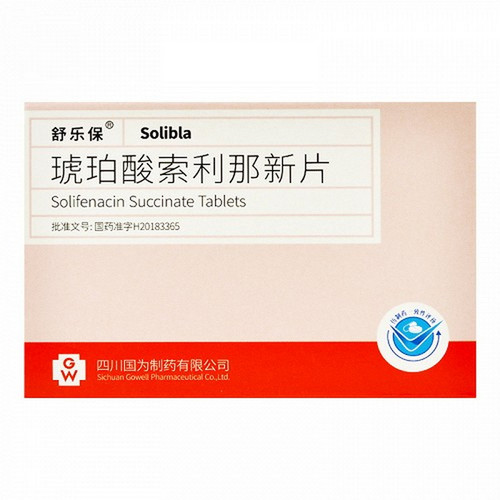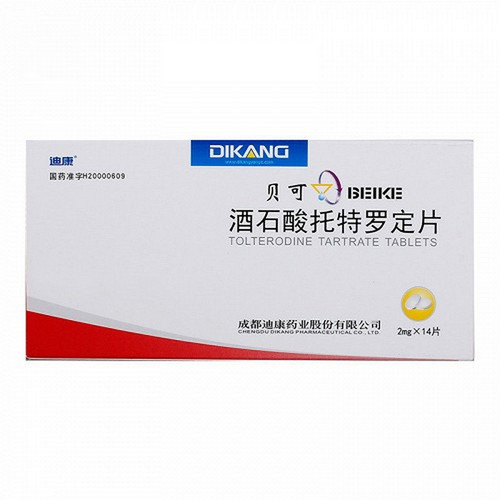Product Overview
[Drug Name]
Generic Name: Solifenacin Succinate Tablets
Trade Name: Weixikang
English Name: Solifenacin Succinate Tablets
Chinese Pinyin: HuPoSuanSuoLiNaXinPian
[Ingredients]
Solifenacin succinate.
[Indications]
For the treatment of urinary incontinence and/or urinary frequency and urgency in patients with overactive bladder.
[Dosage and Administration]
The recommended dose is 5-10 mg daily. For patients with creatinine clearance ≤30 mL/min and moderate hepatic dysfunction (Child-Pugh score 7-9), and when taking other strong CYP3A4 inhibitors such as ketoconazole, ritonavir, nelfinavir, and itraconazole, the maximum dose is 5 mg daily.
[Adverse Reactions]
Infections and Contagions: Uncommon urinary tract infection, cystitis. Psychiatric Disorders: Extremely rare hallucinations. Neurological Disorders: Uncommon somnolence, taste disturbances; Extremely rare dizziness, headache. Eye Disorders: Common: Blurred vision; Uncommon: Dry eyes. Respiratory, Chest, and Mediastinal Disorders: Uncommon: Dry nose. Digestive Disorders: Very common: Dry mouth; Common: Constipation, nausea, dyspepsia, abdominal pain; Uncommon: Gastroesophageal reflux, dry throat; Rare: Colon obstruction, fecal impaction; Very rare: Vomiting. Skin and Subcutaneous Tissue Disorders: Uncommon: Dry skin; Very rare: Pruritus, rash, urticaria. Renal and Urinary Disorders: Uncommon: Dysuria; Rare: Urinary retention. General Disorders and Administration Site Conditions: Uncommon: Fatigue, peripheral edema.
[Contraindications]
This product should not be used in patients with urinary retention, severe gastrointestinal disease (including toxic megacolon), myasthenia gravis, or narrow-angle glaucoma, or in patients at risk for the following conditions: patients with hypersensitivity to the active ingredient or excipients of this product; patients undergoing hemodialysis; patients with severe hepatic impairment; and patients with severe renal or moderate hepatic impairment who are taking strong CYP3A4 inhibitors such as ketoconazole.
[Precautions]
Before using this drug, other causes of frequent urination (heart failure or renal disease) should be identified. If a urinary tract infection is present, appropriate antimicrobial therapy should be initiated. Use with caution in the following patients: significant lower urinary tract obstruction with risk of urinary retention; obstructive gastrointestinal disease; risk of decreased gastrointestinal motility; severe renal impairment (creatinine clearance ≤30 mL/min); in these patients, the dose should not exceed 5 mg once daily; moderate hepatic impairment (Child-Pugh score 7-9); in these patients, the dose should not exceed 5 mg once daily; concomitant use of potent cytochrome P450 3A4 inhibitors such as ketoconazole; patients with hiatal hernia/gastroesophageal reflux and/or current medications that can cause or worsen esophagitis (e.g., bisphosphonates); and autonomic nervous system disorders. The safety and efficacy of this drug in patients with neurogenic detrusor overactivity have not been established. This drug should not be used in patients with hereditary galactose intolerance, Lapp lactase deficiency, or glucose-galactose malabsorption. The maximum effect of solifenacin can be determined as early as 4 weeks after treatment. Effects on Driving and Operating Machinery: Like other anticholinergic drugs, solifenacin may cause blurred vision, drowsiness, and (less commonly) fatigue, which may negatively affect driving and operating machinery.
[Drug Interactions]
Concomitant use with other anticholinergic drugs may result in more pronounced therapeutic and side effects. An interval of approximately 1 week should be allowed between stopping solifenacin and starting other anticholinergic drugs. Concomitant use of cholinergic receptor agonists may reduce the efficacy of solifenacin. Solifenacin may reduce the effects of drugs that stimulate gastrointestinal motility, such as metoclopramide and cisapride.
[Pharmacology]
Solifenacin is a competitive muscarinic receptor antagonist with selectivity for the bladder over the salivary glands. Muscarinic M3 receptors play an important role in several functions primarily mediated by cholinergic activity, including contraction of bladder smooth muscle and stimulation of salivary secretion. Solifenacin succinate inhibits detrusor overactivity by blocking muscarinic M3 receptors on bladder smooth muscle, thereby alleviating the urge incontinence, urgency, and frequency associated with overactive bladder.
[Storage]
Store tightly closed at room temperature (10-30°C). Shelf life: 36 months.
[Strength]
5mg x 10 tablets
[Approval Number]
National Medical Products Administration HJ20140209






